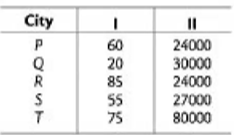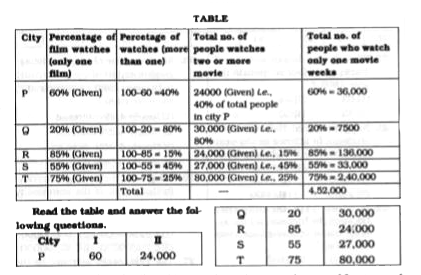Out of the 75 birders, 15 wanted to see only sunbird, 10 wanted to see only flycatcher, 12 wanted to see both sunbird and nuthatch, 15 wanted to see only bee-eater, 13 wanted to see both sunbird and bee-eater, 5 wanted to see both flycatcher and nuthatch and the remaining wanted to see only nuthatch.
How many birders wanted to see only one bird?
A. 30
B. 40
C. 45
D. 50
A
D
B
C
The correct Answer is:D
To solve the problem step-by-step, we can use a Venn diagram to visualize the distribution of birders who want to see different types of birds. Here's how to approach the question:
Step 1: Identify the Groups
We have the following groups based on the information given:
- Only Sunbird (S): 15 birders
- Only Flycatcher (F): 10 birders
- Only Bee-eater (B): 15 birders
- Both Sunbird and Nuthatch (S ∩ N): 12 birders
- Both Sunbird and Bee-eater (S ∩ B): 13 birders
- Both Flycatcher and Nuthatch (F ∩ N): 5 birders
Step 2: Calculate the Remaining Birders
We know there are a total of 75 birders. To find out how many wanted to see only Nuthatch (N), we first need to sum up the known groups:
- Total from the groups:
- Only Sunbird: 15
- Only Flycatcher: 10
- Only Bee-eater: 15
- Both Sunbird and Nuthatch: 12
- Both Sunbird and Bee-eater: 13
- Both Flycatcher and Nuthatch: 5
Calculating the total:
15+10+15+12+13+5=70
Step 3: Determine the Number of Birders Who Want Only Nuthatch
Now, we subtract the total from the overall number of birders:
75−70=5
Thus, 5 birders want to see only Nuthatch.
Step 4: Calculate the Total Number of Birders Wanting Only One Bird
Now, we can find the total number of birders who wanted to see only one type of bird:
- Only Sunbird: 15
- Only Flycatcher: 10
- Only Bee-eater: 15
- Only Nuthatch: 5
Adding these together:
15+10+15+5=45
Final Answer
Thus, the total number of birders who wanted to see only one bird is 45.
We have the following groups based on the information given:
- Only Sunbird (S): 15 birders
- Only Flycatcher (F): 10 birders
- Only Bee-eater (B): 15 birders
- Both Sunbird and Nuthatch (S ∩ N): 12 birders
- Both Sunbird and Bee-eater (S ∩ B): 13 birders
- Both Flycatcher and Nuthatch (F ∩ N): 5 birders
We know there are a total of 75 birders. To find out how many wanted to see only Nuthatch (N), we first need to sum up the known groups:
- Only Sunbird: 15
- Only Flycatcher: 10
- Only Bee-eater: 15
- Both Sunbird and Nuthatch: 12
- Both Sunbird and Bee-eater: 13
- Both Flycatcher and Nuthatch: 5
15+10+15+12+13+5=70
Now, we subtract the total from the overall number of birders:
75−70=5
Thus, 5 birders want to see only Nuthatch.
Now, we can find the total number of birders who wanted to see only one type of bird:
- Only Sunbird: 15
- Only Flycatcher: 10
- Only Bee-eater: 15
- Only Nuthatch: 5
15+10+15+5=45
Thus, the total number of birders who wanted to see only one bird is 45.
Similar Questions
Out of the 100 nature lovers, 20 people wanted to see only bison, 30 wanted to see both bison and tiger, 15 wanted to see only leopard, 25 wanted to see only tiger, 5 wanted to see both bison and leopard and the remaining wanted to see only bear.
How many people wanted to see only one animal?
A. 35
B. 65
C. 60
D. 50View SolutionOut of the 100 nature lovers, 20 people wanted to see only bison, 30 wanted to see both bison and tiger, 15 wanted to see only leopard, 25 wanted to see only tiger, 5 wanted to see both bison and leopard and the remaining wanted to see only bear.
How many people who wanted to see bison did not want to see leopard?
A. 5
B. 15
C. 50
D. 55View Solution
Knowledge Check
- Question 1 - Select One
Out of the 75 birders, 15 wanted to see only sunbird, 10 wanted to see only flycatcher, 12 wanted to see both sunbird and nuthatch, 15 wanted to see only bee-eater, 13 wanted to see both sunbird and bee-eater, 5 wanted to see both flycatcher and nuthatch and the remaining wanted to see only nuthatch.
The difference between the birders who want to see sunbird and those who want to see flycatchers is?ABBCCADD - Question 2 - Select One
Out of the 75 birders, 15 wanted to see only sunbird, 10 wanted to see only flycatcher, 12 wanted to see both sunbird and nuthatch, 15 wanted to see only bee-eater, 13 wanted to see both sunbird and bee-eater, 5 wanted to see both flycatcher and nuthatch and the remaining wanted to see only nuthatch.
The difference between the birders who want to see sunbird and those who want to see flycatchers is?AA. 12BB. 25CC. 30DD. 15 - Question 3 - Select One
Out of the 75 birders, 15 wanted to see only sunbird, 10 wanted to see only flycatcher, 12 wanted to see both sunbird and nuthatch, 15 wanted to see only bee-eater, 13 wanted to see both sunbird and bee-eater, 5 wanted to see both flycatcher and nuthatch and the remaining wanted to see only nuthatch.
The difference between the birders who want to see sunbird and those who want to see flycatchers is?ABBCCADD
Out of the 100 nature lovers, 20 people wanted to see only bison, 30 wanted to see both bison and tiger, 15 wanted to see only leopard, 25 wanted to see only tiger, 5 wanted to see both bison and leopard and the remaining wanted to see only bear.
The ratio of people to wanted to see tiger to those who wanted to see bear is
A. 1/11
B. 11/3
C. 11/1
D. 3/11View SolutionI am not sure why sheiswant∈g–––––––––––––––– to see him
View SolutionA survey of film watching habits of people living in five cities P, Q, R, S and T is summarized below in a table. The column I in the table gives percentage of film-watchers in each city who see only one film a week. The column II gives the total number of film-watchers who see two or more films per week.

How many film-watchers in city R see only one film a week?View SolutionA survey of film watching habits of people living in five cities P, Q, R, S and T is summarised below in a table. The column I in five table gives percentage of film-watchers in each city who see only one film a week. The column II gives the total number of film-watchers who see two or more films per week.

How many film-watchers in city R see only one film in a week ?View SolutionIn the following twenty questions, some parts of the sentences have errors and some are correct. Find out which part of a sentence has an error and blacken the circle corresponding to the appropriate correct option. If sentence is free from errors. Blacken the circle corresponding to "No error"in the Answer Sheet.
I was convinced that the only thing I wanted to do ever, is to write novelsView Solution

